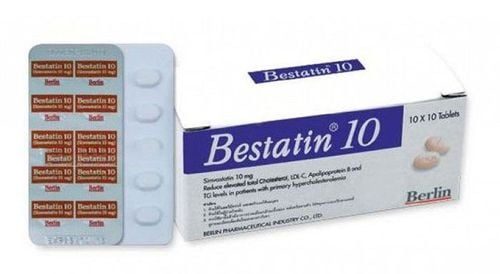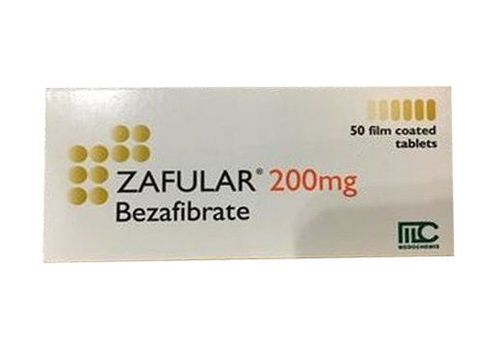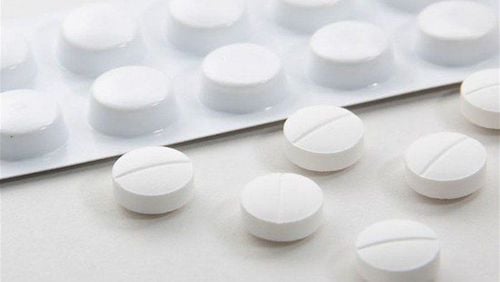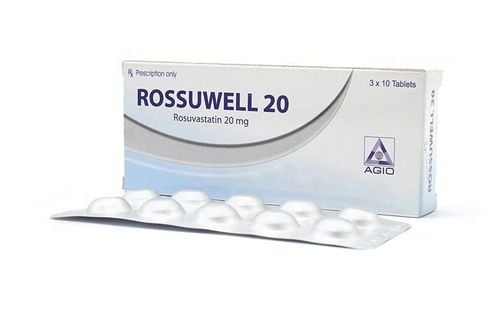This is an automatically translated article.
Sterlow 20 is a drug for the treatment of heterozygous and homozygous primary hypercholesterolemia or mixed dyslipidemia (type llB),... The following article will help you better understand the drug's uses. Sterlow 20.
1. Uses of Sterlow 20
Ingredients:
Active ingredient: Rosuvastatin (as Rosuvastatin calcium): 20mg. Excipients are sufficient. Uses:
Dietary supplement to reduce total cholesterol, LDL-cholesterol, ApoB, nonHDL-C, and triglyceride (TG) levels and increase HDL-C levels in patients with primary hypercholesterolemia (with heterozygous familial and non-familial), and mixed dyslipidemia (Fredrickson types IIa and Iib). Adjunct to diet for the treatment of patients with high serum TG levels (Fredrickson class IV). To reduce LDL-C, total cholesterol and ApoB in hypercholesterolemic patients with homozygous primary hypercholesterolemia, as an adjunct to lipid-lowering therapy (eg, LDL-c heparin. in the blood) or if this treatment doesn't work. Use in combination with dietary modification in patients with primary dyslipidemia (type III hyperlipoproteinemia). Used in conjunction with dietary modification in patients with delayed progression of atherosclerosis h to reduce TC-total cholesterol and LDL-C to target thresholds. Primary prevention of cardiovascular disease. Dosage:
Adults:
The dose range is from 5-40mg. The usual starting dose is 5-10mg once daily: For primary prevention of cardiovascular disease, the dose is 20mg/day. For patients with homozygous familial primary hypercholesterolemia: The starting dose is 20 mg once daily. Children:
For patients with heterozygous familial primary hypercholesterolemia:
Children aged 8 to under 10 years: The recommended dose is 5-10mg once daily. Children 10-17 years old: The recommended dose is 5-20mg once a day. For patients with homozygous familial primary hypercholesterolemia:
Children aged 7-17 years: The recommended dose is 20mg once daily. Asian patients: Initial dose is 5 mg once daily, if treatment goals are not achieved, may be increased to 20 mg/day.
Elderly: The recommended dose is 5mg once a day. No dose adjustment is required according to age.
Patients with liver failure : Do not use.
Patients with renal impairment: Patients with mild or moderate renal impairment do not need to change the dose, do not use the drug for patients with severe renal impairment.
2. Contraindications of Sterlow 20
Do not use for people who are sensitive to any of the ingredients of the drug. Do not administer to patients with advanced liver disease or unexplained persistent high serum transaminases. Not intended for use by women of childbearing potential who are not using effective contraception and breast-feeding. Do not use in patients with severe renal impairment (creatinine clearance <30ml/min). Patient is taking ciclosporin. The 40 mg dose level is contraindicated in patients with: moderate renal impairment (creatinine clearance <60 ml/min), hypothyroidism, family or personal history of hereditary myopathy, history of prior muscle damage This is caused by other HMG-CoA reductase inhibitors or fibrates, alcoholism, conditions that increase blood levels of the drug, Asian patients, taking fibrates.
3. Side effects of Sterlow 20
Common:
Endocrine disorders: Pancreatic diabetes. Nervous system disorders: Headache, dizziness. Digestive disorders: Constipation, nausea, abdominal pain. Musculoskeletal and Connective Tissue Disorders: Myalgia. Systemic and injection site disorders: Asthenia. Uncommon:
Skin and subcutaneous disorders: Pruritus, erythema, urticaria. Rare:
Blood and lymphatic system disorders: Thrombocytopenia. Immune system disorders: Hypersensitivity reactions including angioedema. Digestive disorders: Pancreatitis. Hepatobiliary disorders: Increased liver transaminases. Musculoskeletal and connective tissue disorders: Myopathy (including myositis), rhabdomyolysis. Very rare:
Nervous system disorders: Polyneuropathy, dementia. Hepatobiliary disorders: Jaundice, hepatitis. Musculoskeletal and Connective Tissue Disorders: Arthralgia. Renal and urinary disorders: Hematuria. Reproductive system and mammary gland disorders: Enlarged breasts in men Frequency unknown:
Psychiatric disorders: Depression. Nervous system disorders: Peripheral neuropathy, sleep disturbances (including insomnia and nightmares). Respiratory, thoracic and mediastinal disorders: Cough, dyspnea. Digestive disorders: Diarrhea. Skin and subcutaneous disorders: Stevens-Johnson syndrome. Musculoskeletal and Connective Tissue Disorders: Tendon disorders are sometimes complicated by immune-mediated necrotizing myopathy. Systemic and injection site disorders: Edema.
4. Interactions with other drugs
Carrier Protein Inhibitors: Concomitant use of Rosuvastatin with transporter protein inhibitors including OATP1B1 and BCRP may increase blood levels of Rosuvastatin and increase the risk of myopathy. Protease Inhibitors: Concomitant use of Rosuvastatin with these drugs may increase the risk of muscle damage, most seriously rhabdomyolysis, kidney failure leading to renal failure and possibly death. Gemfibrozil and other lipid-lowering agents: Concomitant use with Rosuvastatin increases the risk of muscle damage. Ezetimibe: Co-administration of Rosuvastatin 10mg and ezetimibe 10mg resulted in a 1.2-fold increase in Rosuvastatin AUC in hypercholesterolemic patients. Antacid: Antacids should be taken 2 hours after taking Rosuvastatin because concomitant use can reduce blood levels of Rosuvastatin by about 50%. Erythromycin: Concomitant use of 2 drugs reduced the AUC and Cmax of Rosuvastatin by 20% and 30%. Other interactions: Increased risk of injury when Rosuvastatin is used concurrently with high-dose niacin drugs, colchicine. Rosuvastatin interacts with alcohol, stomach acid neutralizers, oral contraceptives, itraconazole, enzymes (cholestin, supplements), warfarin.
5. Note when using Sterlow 20
Renal function should be assessed during regular monitoring of the patient at a dose of 40 mg. Liver enzyme tests should be performed prior to initiating treatment with Rosuvastatin and in cases of clinical indications requiring subsequent testing. Increased risk of injury when Rosuvastatin is used concurrently with: gemfibrozil, other fibrate-lowering agents, high-dose niacin (>1g/day), colchicine. Consider creatine kinase (CK) monitoring for appropriate interventions in: Impaired renal function, hypothyroidism, personal or family history of hereditary myopathy, medical history Risk factors for prior statin or fibrate use, history of liver disease and/or heavy alcohol consumption, elderly patients (>70 years) with risk factors for rhabdomyolysis, potential for drug interactions, and some special patient population. Use with caution in patients who consume a lot of alcohol and/or have a history of liver disease. Patients with hypercholesterolemia secondary to hypothyroidism or nephrotic syndrome should be treated prior to taking Rosuvastatin. Discontinue use if pregnancy is detected, and should be informed of the possible risks to the fetus. Rosuvastatin should not be used in patients with hereditary problems of lactose intolerance, Lapp lactase deficiency or glucose-galactose malabsorption. Taking lipid-lowering drugs with drugs to treat HIV and hepatitis C virus (HCV) can increase the risk of muscle damage, even more serious can cause rhabdomyolysis, kidney failure leading to kidney failure. kidneys and can be fatal. If interstitial nephritis is suspected, Stain should be discontinued. Storage:
Store in a dry place, avoid direct sunlight Keep out of reach of children
Please dial HOTLINE for more information or register for an appointment HERE. Download MyVinmec app to make appointments faster and to manage your bookings easily.













